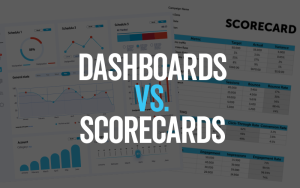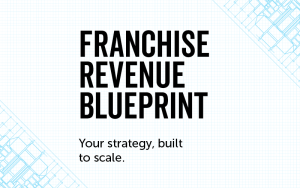Highlights:
- Marketing dashboards offer real-time insights into campaign metrics like ad spend, conversions, and engagement – perfect for making quick, tactical decisions.
- Marketing scorecards provide periodic reviews of long-term goals and KPIs, helping teams stay strategically aligned.
- Dashboards help you optimize active campaigns by flagging what’s working (or not) right now.
- Scorecards help you measure whether marketing efforts are supporting broader business objectives.
- Using both tools together gives multi-location marketers visibility at both the national and local level.
- This combined approach supports better decision-making, tighter team alignment, and improved ROI.
[Revamped for 2025]
Wouldn’t it be nice to take one look at a screen and instantly know how your multi-location marketing campaigns are performing? What’s working, what’s flopping, and whether you’re actually moving the needle on your business goals?
Tools of the Trade: Why Performance Dashboards Matter
Well, good news: You can. Enter the dynamic duo of marketing performance: the marketing dashboard and the marketing scorecard.
These two powerful tools give you a bird’s-eye view and a close-up snapshot of your marketing campaigns. Whether you’re overseeing one location or a hundred, understanding the difference between a performance dashboard and a marketing scorecard is the key to tracking what matters and making smarter decisions more quickly.
Let’s break it all down, without the jargon, but with all the juicy insights.
What Is a Marketing Dashboard?
Think of a marketing dashboard as your campaign’s control room. It’s a real-time visual display of your most important marketing KPIs, metrics, and data. Imagine charts, graphs, and numbers updating on the fly, showing you what’s happening right now. The best part? It’s customizable. Want to track Facebook ad conversions by location? Done. Need to see website bounce rates vs. store traffic? Easy. Think of it as your marketing strategy’s Fitbit—it keeps you constantly in tune with your performance.
For multi-location marketers, this is pure gold. Whether you’re tracking paid ad performance in Pittsburgh or email engagement in El Paso, a dashboard helps you keep your finger on the pulse without digging through spreadsheets.
The Value of a Performance Dashboard
So why does every savvy marketer love their dashboard?
- Customization: Tailor it to show the metrics that matter most for the smartest strategy, whether that’s CPL, store visits, or Instagram engagement by ZIP code.
- Real-Time Tracking: Catch a campaign going off the rails before it crashes and burns (and get it on the right track).
- Team Alignment: Since everyone sees the same data at the same time, you get fewer meetings and more clarity, keeping local and national team players on the same page.
- Better, Faster Decisions: With live performance data, you can adjust tactics on the fly and optimize your spend with the best data-driven decisions. No more waiting for end-of-month reports to realize you might have been able to fund a better strategy.
- Budget Efficiency: Dashboards help you fix what’s not working, reducing overall waste and improving ROI in the moment, not weeks later.
Popular Dashboard Platforms
When it comes to building your marketing dashboard, there are great tools for every budget:
- Google Looker Studio: A free, highly flexible tool that integrates beautifully with Google Analytics 4, Ads, Search Console, and more. Great for DIY dashboard creators. The Pro version lets you access business intelligence with Google Cloud support and system administration.
- Domo: With visualizations for lightbulb moments and easy reporting, along with alerts for instant action, this dashboard is a marketing powerhouse, featuring secure AI for plain language questions and incisive answers. Works for small or large organizations, with a scalable pay structure.
- Agency Analytics: A paid platform offering 80+ integrations, automated reports, SEO tools, and fully customizable dashboards – perfect for agencies or large marketing teams.
Remember: the best dashboard is the one that helps your team take action. Don’t get caught up in bells and whistles if you just need clear, accurate insights.
Related: Beyond the Dashboard: A Predictive Analytics Primer
What Is a Marketing Scorecard?
Now let’s talk about the marketing scorecard—your trusty tracker for long-term strategy and goal alignment. While dashboards zoom in on daily activity, scorecards take a step back and ask, “Are we actually moving toward our goals?”
Think of scorecards as your quarterly performance review, with clear metrics and milestones. For franchise and multi-location brands, they’re especially useful for aligning franchisees, local managers, and corporate teams around shared business objectives, where tracking long-term results across a variety of regions and stores is key.
The Value of a Marketing Scorecard
- Team Alignment: Everyone knows the goals and how close you are to hitting them.
- Simple, Consistent Check-Ins: Review weekly, biweekly, or monthly. Easy to digest, no data science degree required.
- Strategic Clarity: See where progress is strong and where it’s stalling; spot trends, seasonality, and growth by location or campaign.
- Improved Communication: Scorecards encourage better dialogue around what’s working (and what’s not). Meetings get shorter—and smarter!
- Accountability: Scorecards help team members tie their work to larger business outcomes and allow local teams to see how their efforts ladder up to national goals.
Related: How to Update Your Marketing Scorecard
What to Include in a Marketing Scorecard
A solid marketing scorecard should be clean, simple, and to the point. Here are your must-have elements:
- Key Performance Indicators (KPIs): Your measurable targets (e.g., lead volume, ROAS, email conversions).
- Goals for Each KPI: What are you aiming for? Be specific (and realistic).
- Leading Indicators: Early metrics that help forecast future success, like web traffic or ad impressions.
- Marketing Campaign Performance: How did this initiative stack up? What should you test next?
- Ownership Tags: Assign a specific person or team to each KPI.
- Relevant Context: Be sure to include the time period, target audience, and any other pertinent factors.
Keep in mind: Scorecards can be simple or complex depending on your business goals. For multi-location brands, corporate teams often use more detailed scorecards to measure national performance and long-term benchmarks, while local franchisees may work with streamlined versions focused on leads, calls, and visits.
Want to go the extra mile? Add a percentage of goal achieved, strategic notes, or status updates for each campaign. Just don’t clutter it. A bloated scorecard helps no one.
Performance Dashboard vs. Scorecard: What’s the Difference?
Let’s end the confusion. Here’s the clearest way to think about it:
- Marketing Dashboards = real-time insight for daily/tactical decisions
- Marketing Scorecards = periodic progress review for strategic alignment
One helps you optimize campaigns while the other helps you track progress toward goals. They’re not competitors—they’re collaborators.
Dashboard vs. Scorecard
| Performance Dashboard | Marketing Scorecard | |
| Focus | Real-time performance | Progress toward goals |
| Timeframe | Immediate to daily | Weekly, monthly, or quarterly |
| Purpose | Optimize campaigns and spot issues | Align strategy and track goals |
| Best For | Ensuring a current campaign is optimized | Guiding long-term efforts to hit larger KPIs |
How to Make Both Work for You: Use Cases
Whether you’re running marketing for a single brand, multiple regions, or a franchise network with dozens of unique locations, combining dashboards and scorecards gives you both immediacy and insight.
- Use dashboards to monitor real-time performance: Ad spend, clicks, conversions, store traffic – they help you make adjustments fast. Use a dashboard to track your multi-channel Labor Day marketing campaign in real time, and make changes based on real conversions (or lack thereof).
- Use scorecards to track campaign impact over time: Are leads up quarter-over-quarter? Are we hitting CPL targets in all regions? Scorecards keep you goal-focused and big-picture-oriented. Now look at your Labor Day marketing campaign compared to your entire fall lineup. Are you reaching your Q3 marketing goals? Has your growth continued past the second quarter?
Let the Data Guide Your Campaign
Marketing is part art, part science. When looking at dashboards vs. scorecards, dashboards show you the data in real time, while scorecards connect that data to long-term goals. Together, they balance the science and the art, giving you a full-color, high-res view of performance across every store, channel, and campaign.
And let’s be honest: Building dashboards and scorecards sounds great…until you’re elbows-deep in data connectors, filters, and acronyms. That’s where we come in.
At Ironmark, we help marketers build dashboards and scorecards that not only look great, but actually help drive smarter campaigns, stronger strategies, and better sales. We are the simplifiers, here to make marketing magic by helping you manage the moving parts.
Want a dashboard that doesn’t give you decision fatigue? A scorecard that actually sparks team conversations? Let’s talk. Your data has a story to tell. We’re here to help you read it and give it the best ending possible.



